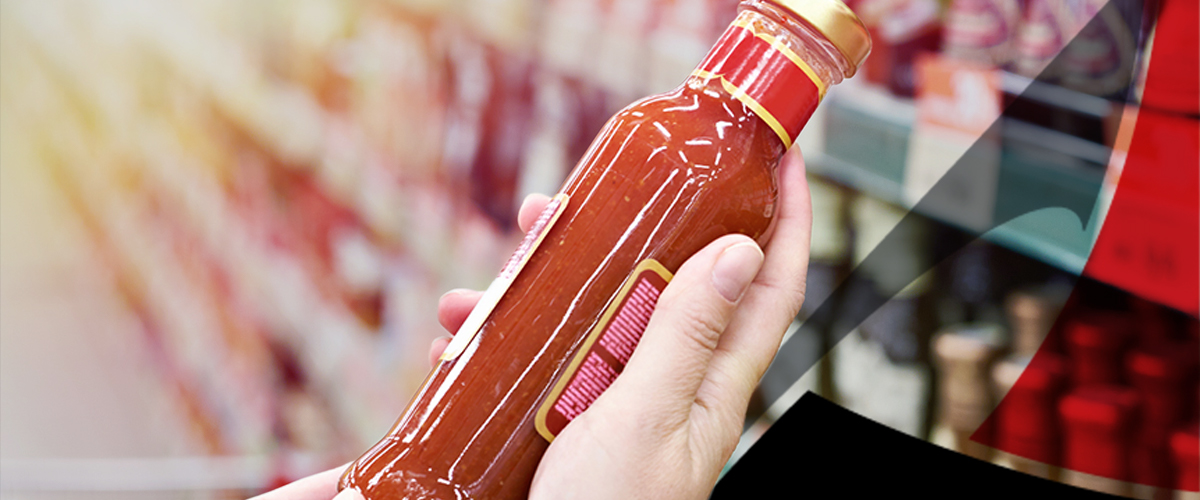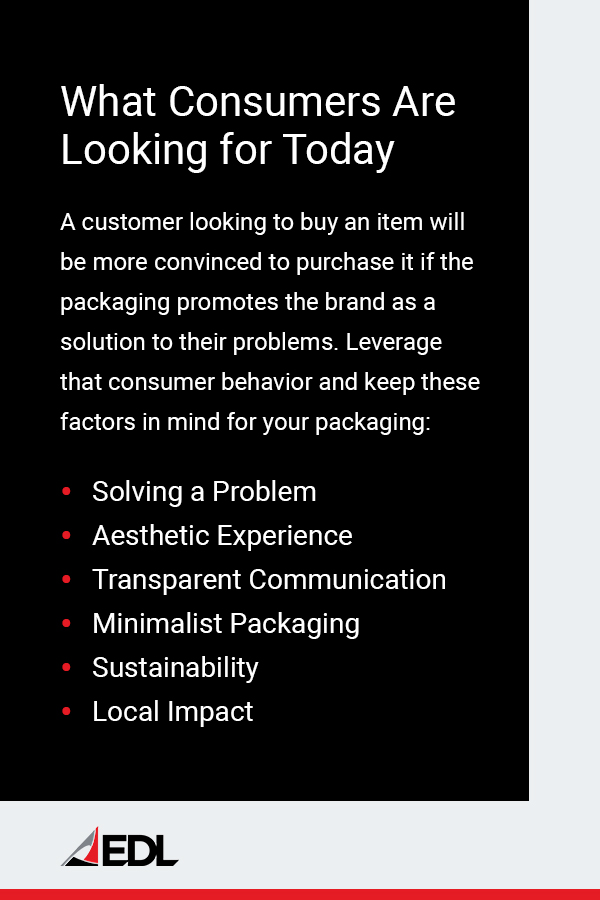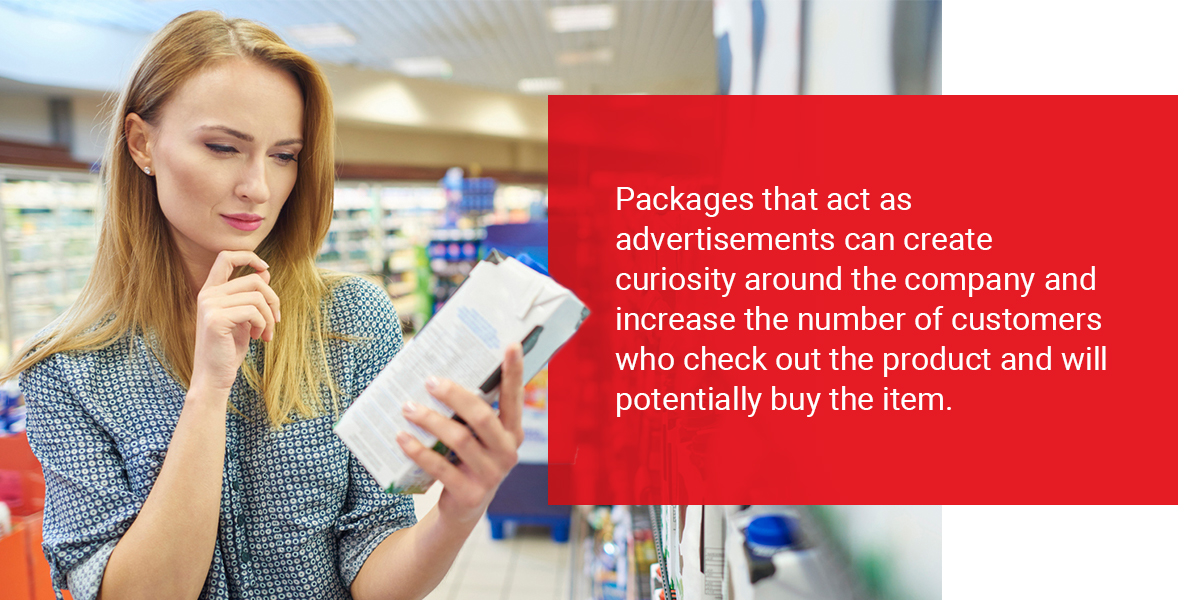15 April 2022 //
The design of a product’s packaging will often influence customers to buy something if they are convinced that the item is reliable and trustworthy. Packaging can convey emotions through design aspects like color, logos or text and persuade consumers that a specific brand offers the perfect solution to a person’s needs.
Companies can use knowledge of the current market and typical customer to their advantage and create a package that positively influences consumer behavior.
How Does Packaging Influence Behavior?
A product’s packaging can influence consumers’ emotions through aspects like color, typography and material. Bright colors, readable font and quality material can convince customers that your product is reliable. There are a few emotions and responses that describe how product packaging affects consumer behavior:
- Spontaneity: A customer will respond to an advertisement or display, such as a child looking at a brightly colored Barbie, and buy something they didn’t plan to.
- Compulsion: Some packaging conveys an urgency to make purchasing decisions, such as limited-edition products or items on sale.
- Excitement: Customers may feel excitement or happiness when products are appealing or mysterious.
- Inclusivity: Packaging can convey feelings of inclusiveness or a desired lifestyle. It can also promote a product to a certain income bracket or social group.
- Cohesion: Customers may find packaging instantly appealing and are often motivated to impulsively buy products due to the packaging. For example, food packaging that looks appetizing will appeal to hungry customers.
What Consumers Are Looking for Today
Today’s consumers are drawn to packaging and products that meet their needs. A customer looking to buy an item will be more convinced to purchase it if the packaging promotes the brand as a solution to their problems.
Leverage that consumer behavior and keep these factors in mind for your packaging:
Solving a Problem
These product packages address specific issues or needs within their consumer base. For example, food products may require different packaging designs if consumers don’t find the food appealing. Problems are addressed through packages that attempt to solve the issues and promote a solution to each customer.
Aesthetic Experience
A brand’s packaging should stand out among other products. When most brands stick to a particular design, switching up the typical aesthetic may draw more consumers to your product.
Transparent Communication
Packaging should be transparent about the product and clearly state what the product does. All labeling and other information communicate how the item can help the consumer. For example, any item that claims to be a skincare product should be healthy for the skin and communicate that benefit through packaging.
Minimalist Packaging
Today’s product packaging is more minimalistic while maintaining a vintage aesthetic. Brands that want to attract consumers should keep this in mind when designing packaging that will convince people to buy the product.
Sustainability
As the world becomes environmentally aware, current packages must portray products as eco-friendly and sustainable. Marketing strategies should emphasize this to ensure the company is focused on protecting the environment. Younger consumers may search for brands that care about recyclable materials and biodegradable boxes.
Local Impact
Taking a local approach to packaging may be essential for a brand’s impact in specific areas. Companies can identify what their local customers need and appreciate while adapting their packaging to market to those consumers. For example, regions that enjoy specific foods from an area will continue to buy products catered to this demographic.
The Impact of Packaging Color on Consumer Behavior
Color is one of the most influential parts of product packaging. It conveys specific emotions or appeals to consumers through brand awareness and nuance. Color can also help communicate the product’s attributes or explain the expectations of happiness or satisfaction that consumers may have when they buy an item.
While it is often used to help customers decide what brand to purchase, packaging color is integral in creating trust in the consumer before they buy a product. There are several ways that different colors can convey emotion and best promote specific brands.
Red
Red is often used to promote reliability and draw the buyer in through high-energy emotion. This color can increase the heart rate and signal an adrenaline rush that conveys intense emotions to the customer. It is also associated with feelings like love and sensuality. Red encourages impulse buying and creates a sense of urgency, which is why it is often used in clearance sales.
Red can also be used for safety products since the color is associated with visibility. Consumers link red to safety through products like first aid kits or stop signs. Other safety brands can take advantage of this when designing their packaging.
Orange
Orange is an attention-grabbing color, so using it in small packaging areas can make it stand out among other colors. Consumers find orange appealing and pleasant, giving off emotions of happiness and positivity. It can also evoke joy, enthusiasm and determination while motivating customers to buy your product. Orange is a wonderful color to use in packaging food products, hardware tools or items that want to invoke freshness.
Yellow
Yellow can be a bright color that attracts a customer’s gaze. It is a popular choice for clearance sales and gives off feelings of warmth, happiness and optimism. Yellow can also boost energy and heighten mental activity. However, overuse of the color can give customers feelings of anxiety.
Green
Green reminds consumers of nature and freshness, making it an excellent packaging color for environmentally friendly products. It is also the go-to color for products that involve a call to action and can invoke various feelings, from invigoration and productivity to relaxation and calmness. Since this color is associated with nature, purity and health, products that involve cleanliness or growth work best with green packaging.
Blue
Blue is a calming color that tends to dispel nervous or anxious energy. It can promote calmness or tranquility in customers who associate the color with water or the sky.
For difficult purchasing decisions, blue may assist customers in making hard choices, as it also produces calming hormones, slows breathing and lowers the heart rate. This relaxing color is great for products that want to display enthusiasm for their product or sincerity in their brand image.
Purple
Purple is not often used in packaging and can give consumers a sense of freshness when buying the product. The color is often associated with royalty or luxury and induces feelings of power and dignity. Using bluer purples may promote feelings of relaxation, while redder purples represent ambition. A violet shade will also remind customers of wisdom, mystery or creativity.
Pink
Pink is gentler than red and has an innocent and tender appearance. This color is often associated with children or youth and represents positivity and hope. Pink tends to be associated with femininity and is often used in packaging aimed toward women or young girls.
Remember that some customers may be wary of pink due to perceptions of the “pink tax” — products marketed toward women having a higher cost — making them avoid the product altogether.
Black
Black is a versatile color and pairs well with other color schemes. This color represents elegance, power and sophistication. High-end products and luxury brands often use black to communicate this.
White
White reminds customers of purity and simplistic ingredients. It is an elegant color, often representing innocence or a sterile environment. White is an excellent accent color when paired with the brand’s primary palette and can be used in product packaging to symbolize newness or youthfulness.
Gray
Gray is a neutral color. It can invoke feelings of relaxation, calm and balance or convey a lack of energy. Gray also symbolizes maturity and is best used as an accent color paired with the primary color used by the brand.
Each color carries with it an explanation of the customer’s sensory experience. A package that contains a scented product will usually match its corresponding color. For example, natural scents like pine, tea tree or eucalyptus are associated with the color green. Floral scents like lavender or cherry are often paired with purple or bright pink, and consumers will expect these color pairings when buying a product.
Branded Packaging’s Influence on Consumer Behavior
A well-established brand will make it easier for consumers to make purchasing decisions when it comes to different products. Someone with little to no knowledge of an item is more likely to prefer the well-known brand name product over anything else.
Strong brand influence also builds trust within consumers. People will share their purchasing decisions with friends or family and spread brand trust through word-of-mouth, extending this trust to other products made by the same company. Consumer’s who enjoy a product will buy it again and again.
Branding can communicate the benefits of a product or company’s service while enabling the audience to understand a brand’s goals. Companies can build brand loyalty by ensuring their packaging conveys a mission statement, the company’s core values and how the product solves an issue.
If your company offers a variety of products, consider a cohesive design among them. Customers may recognize your brand logo, colors and packaging shapes on a product they wouldn’t usually buy. Their awareness with your brand may encourage them to purchase something new.
A brand that incorporates its image on the packaging can become better at advertising. Packaging can tell a narrative to the customer and increase brand awareness. Packages that act as advertisements can create curiosity around the company and increase the number of customers who check out the product and will potentially buy the item.
How Packaging Images and Typography Influence Customer Decisions
The packaging’s images, symbols and typography convey the product’s branding and make it easy for consumers to recognize the item. Logos become shorthand for the brand that exists behind the symbol. For example, the golden arches of McDonald’s or the Apple logo of the iPhone are well-known among customers who trust the brand and instantly recognize their symbols.
Icons, logos and designs can attract customers when they are placed prominently on the packaging. Using symbols in the place of text may also provide a less cluttered look and convey information about the product and brand quickly.
Appealing Graphics Attract the Consumer
Cluttered layouts, hard-to-read fonts or excessive content may deter consumers from buying a product. The graphics of a packaging design are integral in conveying the characteristics and usage of a product and the influence it will have on a customer.
Here are a few ways brands can use graphics to attract consumers:
- Limit the number of fonts: Stick to two fonts and avoid fitting too much information into small areas.
- Use white space: Avoid clutter by utilizing white space — or blank areas, depending on your packaging color — and realize that less is more.
- Watch for printing limits: Design aspects may push the printing or reproduction quality boundaries.
- Adhere to regulation requirements: Packaging designs should adhere to graphic regulations to avoid delays.
- Steer clear of intricate designs: Detailed illustrations may make printing difficult, especially on smaller packaging.
How Customers Respond to Product Finish, Material and Shape
The product packaging material may deter a customer from choosing a brand. Material that seems flimsy or prone to breakage may stop a consumer from buying a product. It is essential to design packaging that is high-quality, eco-friendly and shaped interestingly to draw in customers and promote the brand.
Shape and Branding
Companies can use the shape of a package for branding. Uniquely shaped boxes will set the product apart within the marketplace of similar products and attract customers to the item. Sometimes, larger packaging will draw in consumers who perceive larger things as more significant in value. Just ensure the product inside the box meets those expectations.
Elongated shapes tend to be more attractive than conventional shapes, while unusual or eye-catching packages can appeal to specific demographics. For example, children may gravitate to animal-shaped boxes or packaging with a favorite character displayed on the front.
Eco-Friendly Packaging
Using recyclable and biodegradable material in packaging says that a company cares about the environment. Some consumers will gravitate toward packages that display an effort to be eco-friendly. Brands should be authentic about their recyclable packaging, as poor products could create distrust within consumers who feel that the company is not being truthful about its environmental efforts.
Quality Material
Quality material is attractive to customers who look for packaging that is properly fastened and made with a sturdy design. Consumers may be less inclined to buy an item if they think the packaging is of poor quality. Different materials can also convey additional messages. For example, velvet boxes imply wealth or luxury, while a plain box made from recycled cardboard says that the company is eco-friendly.
Use EDL Packaging to Create Custom Packaging Solutions
At EDL Packaging, we focus on secondary packaging through advanced designs. Our company is dedicated to helping our customers succeed and provides cost-effective options for protecting products that need transporting, storing or retailing.
EDL Packaging applies more than 50 years of packaging experience to meet customers’ unique requirements. We offer shrink wrappers and bundlers, corrugated tray formers and loaders, roll wrappers and semi-automatic wrappers. Contact us online to talk to a representative.





